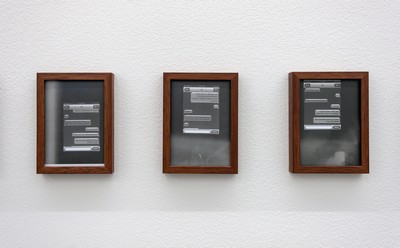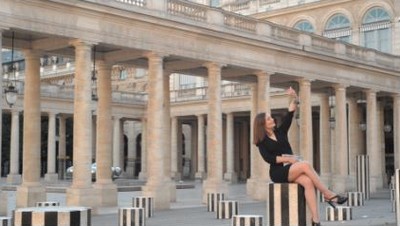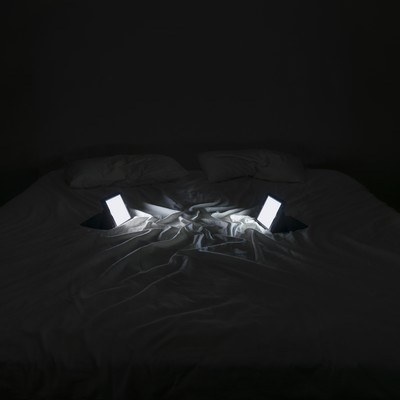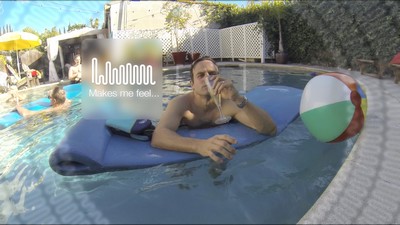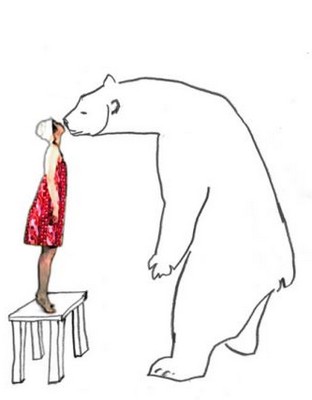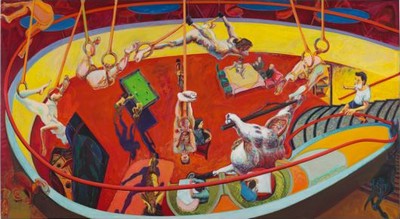Modern Love
or Love in the Age of Cold Intimacies
ΕΜΣΤ - EMEST - National Museum of Contemporary Art Athens
Through 5 November 2023
I Don't Know You So I Can't Love You, 2018 (detail)
Courtesy of the artist
I Don’t Know You, So I Can’t Love You, 2018 (detail)
Installation, smart assistants, speakers, pigment prints
Courtesy of the artist
Installation view: Museum für Neue Kunst, Freiburg, DE
Photo: Bernhard Strauss
I Don't Know You So I Can't Love You, 2018 (detail)
Courtesy of the artist
ΕΜΣΤ | EMEST | National Museum of Contemporary Art, Athens presents Modern Love (or Love in the Age of Cold Intimacies), a major group exhibition curated by artistic director Katerina Gregos.
The subtitle of the exhibition is a reference to Eva Illouz’s book, Cold Intimacies: The Making of Emotional Capitalism, which argues that these relationships have become increasingly defined by economic and political models of bargaining, exchange, and equity. Modern Love (or Love in the Age of Cold Intimacies) explores the state of love and human bonds in the age of the Internet, social media, and high capitalism, probing how the digital sphere, the impact of technology giants, and neo-liberal practices have transformed love, social relations, and the way we interact with one another.
Artificial Humors, 2016 (video still)
Single channel video, colour, sound, 29’
Produced by Herma Films, with the financial support of
Fundação de Serralves (PT), Bienal de São Paulo (BR),
Colección Inelcom (SP), ICA - Instituto do Cinema e do Audiovisual (PT)
Courtesy of the artist and Galeria Francisco Fino, Lisbon
Liberdade, 2011 (video still)
Single-channel video, colour, sound, 17΄
Produced by A Mutual Respect Productions,
with the financial support of Toyota de Angola
Courtesy of the artist and Galeria Francisco Fino, Lisbon
TLDR, 2017 (video still)
13-Channel Video Installation
Commissioned by the B3 Biennial of
the Moving Image, Frankfurt am Main
Courtesy of the artist
TLDR, 2017 (video still)
13-Channel Video Installation
Commissioned by the B3 Biennial of
the Moving Image, Frankfurt am Main
Courtesy of the artist
Night Soil - Economy of Love, 2015 (video still)
Single channel video projection, colour, sound, 32’ 46’’
Courtesy the artist and AKINCI, Amsterdam
The accessibility of the Internet to an ever-greater number of people has had liberating effects, encouraging and empowering more open and diverse lifestyles, contributing to the dissolution of interpersonal orthodox conventions and social constrictions, and crumbling taboos and biases around gender and sexuality.
In Between. The warmth. 2017/2020 (detail)
Inkjet prints on Fine Art paper, variable materials
Courtesy of the artist
if you need me i’ll be pretending things will be different this time, 2019
From the series Niche Content for Frustrated Queers
Meme, variable dimensions
Courtesy of the artist and Arcade, London
Modern Love (or Love in the Age of Cold Intimacies) looks at how the Internet has facilitated the expression of non-heteronormative sexual identities, especially in societies where queerness or non-binary sexuality are considered taboo, or even forbidden. It also explores the human pathologies associated with the commodification of emotion and the effects of digital dependency on relationships, as well as the issues that arise when the boundaries between the public and private, as well the virtual and the real, become more and more fluid. The Covid-19 pandemic and physical distancing have added yet another challenge to achieving fulfilling, intimate and meaningful human interaction.
Deadly Nightshade, 2020
Oil on canvas, 120 x 230 cm
From the collection of the Centraal Museum, Utrecht
Do You Have Work Tomorrow?, 2013 (detail)
Series of 32 screen shots of a staged conversation on an iPhone,
transformed into black and white photographs
developed in a dark room, framed, 18 x 13 cm (each)
Courtesy of the artist and Gypsum Gallery, Cairo
Old Stock Collection: Look 3 (Purple Vagina Face), 2019
Mixed media with silk, satin, tulle
From the collection of the Centraal Museum, Utrecht
At the same time, we also live in a time that philosopher Byung-Chul Han has labelled “emotional capitalism”, where human emotions have been co-opted by market forces. Thus, apart from offering an open and potentially endless sense of possibility, the dating supermarkets of Tinder and Grindr, “speed dating”, and the ease of Internet exchange have also hollowed out relationships and led to selfish or narcissistic forms of behaviour and the creation and curation of misleading images of the self, making it ever more difficult to establish what is real, meaningful, or true.
Our Cold Loves, 2022 (video still)
Single channel video projection, colour, sound, 32’ 31’’
Courtesy of the artist and Michel Rein Paris | Brussels
Our Cold Loves, 2022 (video still)
Single channel video projection, colour, sound, 32’ 31’’
Courtesy of the artist and Michel Rein Paris | Brussels
Modern Love (or Love in the Age of Cold Intimacies) is as much about individuals as it is about the systems of control that bind us together. Equally, it is about new societal patterns, investigating the challenges and possibilities that the Internet and social media present. It recognises love as a potent emotional force and intense psychological bond between people that gives meaning to our lives in ways that no other interaction, object, or experience can.
Soft Touch, 2015/2022 (video still)
HD video, Color, Sound, 5΄
Courtesy of the artist
Man Staring, London, 2022
Pigment print, 44 x 33 cm
Courtesy of the artist and Hot Wheels, Athens
At a time of increasing alienation, individualism, and loneliness – symptoms of our world’s increasingly urbanised lifestyles – how can we reclaim meaningful intimate relationships? How can love be rescued from the claws of capitalism and the corporate technosphere? How can one resist the instrumentalisation of love, its superficialisation and banalisation by commerce and social media? Modern Love (or Love in the Age of Cold Intimacies) looks into the pathologies and problems afflicting love and matters of the heart and attempts to imagine a way out of our current alienation, emotional sterility, and loneliness.
With dog and kids in the park (Balance), Budapest, 2019
From the series The Hero Mother – How to build a house, 2016-2019
Courtesy of the artist and Glassyard Gallery, Budapest
I You Me We Us, 2018
16mm film on two monitors, 16΄
Courtesy of the artist
Focus Wear, 2020 (installation view)
Various textiles, steel (180 x 50 x 45 cm and 170 x 55 x 45 cm)
Courtesy of the artist
Photo: Pinelopi Gerasimou
The product of ongoing research, the exhibition – which features 24 artists from 14 countries – comes to Greece after presentations at the Museum für Neue Kunst (Germany), Tallinna Kunstihoone (Estonia), IMPAKT [Centre for Media Culture] and Centraal Museum (Netherlands). For the exhibition at EMΣT - EMEST Athens, Modern Love (or Love in the Age of Cold Intimacies) has been expanded to additionally include Greek as well as international artists, most of whom are presenting their work for the first time in Greece.
Modern Love (or Love in the Age of Cold Intimacies) is accompanied by a bilingual (English-Greek) publication designed by Rafaela Drazic and edited by Katerina Gregos and Theophilos Tramboulis.
ARTISTS
Gabriel Abrantes (1984, US/PT)
Andreas Angelidakis (1968, GR)
Melanie Bonajo (1978, NI)
Candice Breitz (1978, ZA)
Laura Cemin (1992, IT)
Benjamin Crotty (1979, US)
Kyriaki Goni (GR, 1982)
David Haines (1969, UK)
Juliet Jacques (1981, UK)
Sanam Khatibi (1979, IR/BE)
Mahmoud Khaled (1982, EG)
Duran Lantink (1988, Nl)
Ariane Loze (1988, BE)
Maria Mavropoulou (1989, GR)
Lauren Lee Mccarthy (US)
Kyle Mcdonald (US)
Marge Monko (1976, EE)
Eva Papamargariti (1987, GR)
Peter Puklus (1980, RO/HU)
Yorgos Prinos (1977, GR)
Marijke De Roover (1990, BE)
Margaret Salmon (1975, US/UK)
Hannah Toticki (1984, DK)
István Zsíros (1985, HU)
ΕΜΣΤ | EMEST - National Museum of Contemporary Art
Kallirrois Ave. & Amvr. Frantzi Str. (Former Fix Factory), Athens, 11743
Modern Love (or Love in the Age of Cold Intimacies) | EMΣT Athens - 15.12.2022 - 05.11.2023













